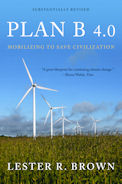The sandwich model of social change is in many ways the most attractive one, partly because it brings a potential for rapid change. As of late 2009, the strong grassroots interest in cutting carbon emissions and developing renewable sources of energy is merging with the interests of President Obama and his administration. One result is a near de facto moratorium on building new coal plants.
There are many signs that the United States may be moving toward a tipping point on climate, much as it did on civil rights in the 1960s. Though some of the indicators also reflect the economic downturn, it now seems likely that carbon emissions in the United States peaked in 2007 and have begun what will be a long-term decline. The burning of coal and oil, the principal sources of carbon emissions, may be declining. And with the cars to be scrapped in 2009 likely to exceed sales, the U.S. automobile fleet size may have peaked and begun to shrink.
The shift to more fuel-efficient cars over the last two years, spurred in part by higher gasoline prices, was strongly reinforced by the new automobile fuel efficiency standards and by rescue package pressures on the automobile companies to improve fuel efficiency. The combination of much more demanding automobile efficiency standards, a dramatic restoration of funding for public transit, and an encouraging shift not only to more fuel-efficient gas-electric hybrid cars but also to both plug-in hybrids and electric cars could dramatically reduce gasoline sales. The U.S. Department of Energy in past years had projected substantial growth in U.S. oil consumption, but it has recently revised this downward. The question now is not will oil use decline, but how fast will it do so.
Shifts within the energy sector, with rapid growth in wind and solar energy while coal and oil are declining, also signal a basic shift in values, one that could eventually alter every sector of the economy. If so, this, combined with a national leadership that shares these emerging values, could lead to social and economic change on a scale and at a pace we cannot now easily imagine.
Of the three models of social change, relying on the Pearl Harbor model is by far the riskiest, because by the time a society-changing catastrophic event occurs, it may be too late. The Berlin Wall model works, despite the lack of government support, but it does take time. Some 40 years elapsed after the communist takeover of the governments of Eastern Europe before the spreading opposition became strong enough to overcome repressive regimes and switch to democratically elected governments. The ideal situation for rapid, historic progress occurs when mounting grassroots pressure for change merges with a national leadership committed to the same change. This may help explain why the world has such high hopes for the new U.S. leadership.
Adapted from Chapter 10, “Can We Mobilize Fast Enough?” in Lester R. Brown, Plan B 4.0: Mobilizing to Save Civilization (New York: W.W. Norton & Company, 2009), available on-line at www.earthpolicy.org.


Dara
You may be interested in this link to a news release announcing a major boost to the Media & Policy Center’s “Growing Greener Schools” initiative: mediapolicycenter.org. The project, which includes the airing of a documentary on PBS stations next April, encourages local community support for establishing healthier, greener schools for our children.